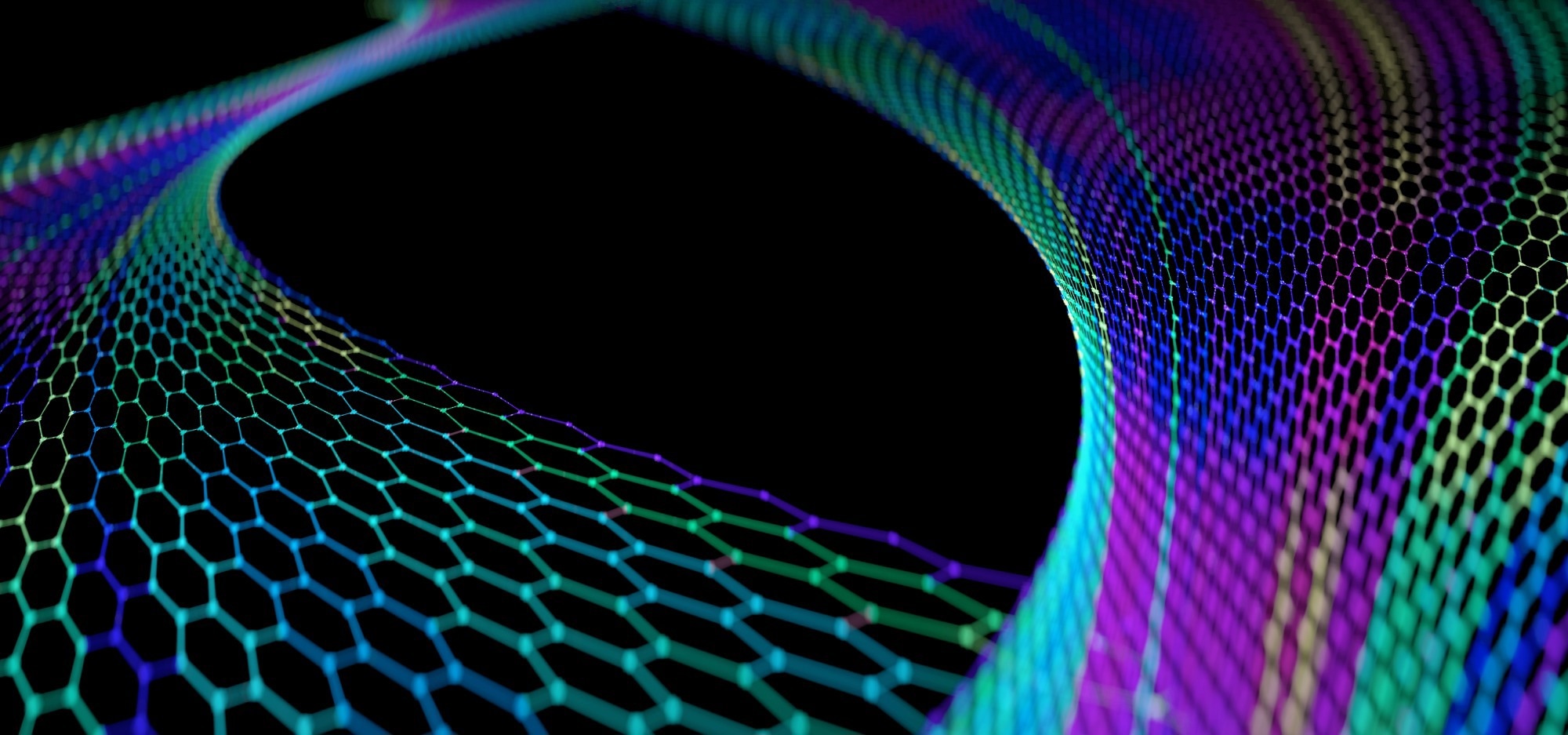 By Owais AliReviewed by Lexie CornerAug 30 2024
By Owais AliReviewed by Lexie CornerAug 30 2024Often hailed as the "wonder material of the 21st century," graphene continues to captivate researchers and industry leaders with its extraordinary properties and vast application potential. This article overviews recent breakthroughs in graphene research, showcasing how this remarkable material pushes the boundaries of science and technology.

Image Credit: Marco de Benedictis/Shutterstock.com
Since its discovery in 2004, this single layer of carbon atoms arranged in a honeycomb structure has demonstrated a remarkable combination of characteristics that set it apart from any other known material.
Graphene is the thinnest material known—just one atom thick—yet it is 200 times stronger than steel. Despite this incredible strength, it is flexible and lightweight and conducts electricity and heat better than any other material at room temperature.
These properties, combined with its transparency and impermeability to most gases and liquids, make graphene an ideal candidate for revolutionizing numerous industries.1
Newly Discovered Graphene Properties
Despite being discovered nearly two decades ago, scientists continue to uncover innovative properties of graphene.
Ferroelectric Properties of Bilayer Graphene
In a study published in Nature, MIT researchers discovered unconventional ferroelectricity in bilayer graphene. They found that graphene can exhibit spontaneous charge separation between layers without an external electric field, challenging existing assumptions about ferroelectric systems.
This new property, coupled with graphene's excellent electrical conductivity, has significant potential for advancing faster information processing, especially in neuromorphic computing, and may lead to the development of new ferroelectric materials.2
The Most Magneto-Resistant Material
Graphene has been identified as the most magnetoresistant material—it can change its electrical resistance in response to a magnetic field more rapidly and pronouncedly than other materials like graphite or bismuth, and it displays this property at room temperature.
Researchers at the University of Manchester found that graphene's resistance changes dramatically even under small magnetic fields due to its highly mobile charge carriers. This property, combined with graphene's strength and conductivity, could transform data storage technology and open new avenues in fundamental physics.3
Enhanced Conductivity and Efficiency
Scientists at Nanografi Nano Technology have developed "holey super graphene," a variant with engineered pores that enhance conductivity up to 3.3 times compared to traditional multi-layered graphene.
This porous structure increases surface area, enabling faster battery charging, improved energy storage, and better sensor performance. It also facilitates ion passage and provides attachment sites for functional chemical groups, offering new opportunities in energy storage, gas separation, and water purification.4
New Graphene Production and Processing Techniques
As graphene research advances, scientists and engineers are innovating new methods to produce and process the material more efficiently and at larger scales.
Cost-Effective Dry Graphene Manufacturing
NanoXplore Inc. recently introduced a cost-effective and scalable dry graphene manufacturing process, leveraging advanced exfoliation technology. This method reduces capital expenditures by nearly 50 % compared to traditional liquid exfoliation, costing an estimated $20M for an 8,000 metric ton capacity.
It also requires low-grade waste graphite as feedstock, making it more scalable and environmentally friendly than traditional methods.5
Non-Toxic Gurzeda Method for Graphene Oxide
Researchers at Umeå University have developed the Gurzeda method, a non-toxic approach for producing high-quality graphene oxide. This technique integrates elements from the established Hummers and Brodie methods to produce graphene oxide with significantly fewer defects, enhancing its suitability for electronics and protective coatings applications.6
Oxygen-Free CVD Method for Large-Scale Graphene Production
In a significant step towards large-scale production of high-quality graphene, Columbia University engineers have developed an oxygen-free chemical vapor deposition (OF-CVD) method. This method addresses previous issues with graphene quality by eliminating trace oxygen, which interfered with the growth process and affected the material's properties. In addition, it ensures reproducibility and high quality, matching the performance of exfoliated graphene.7
Recent Advances and Innovative Applications Across Industries
World's First Graphene Semiconductor Outperforms Silicon Chips
In a recent study in Nature, Georgia Tech researchers developed the world's first functional graphene semiconductor by growing it on silicon carbide wafers and doping it to create transistors.
The study demonstrated that electrons flow through graphene more efficiently than silicon, potentially leading to faster and more efficient computers. While transitioning from silicon to graphene involves challenges like cost, durability, and manufacturing ease, researchers view graphene as a key element in the next major leap in electronics.8
Graphene-Based Implantable Technology
A recent study in Nature Nanotechnology introduced EGNITE (Engineered Graphene for Neural Interfaces), an innovative graphene-based neurotechnology. It features flexible, high-resolution graphene implants with microelectrodes as small as 25 µm, offering low impedance and high charge injection—key for effective neural interfaces.
Preclinical trials have shown that EGNITE can record high-fidelity neural signals and deliver precise nerve stimulation, offering transformative potential for neuroelectronic therapeutics.9
Graphene-Coated Sand for Smart Concrete and Electrically Heated Pavements
Salgenx is expanding the use of its graphene and hard carbon-coated sand from advanced battery systems to the construction industry.
This graphene-coated sand could improve concrete's electrical conductivity, mechanical strength, and durability, enabling smart concrete that monitors structural health in real-time, detects strain and cracks, and supports predictive maintenance. Its conductive properties could also facilitate electrically heated pavements to prevent ice and potentially charge electric vehicles.10
Conclusion
Graphene's remarkable properties—strength, flexibility, and superior conductivity—are driving innovations across multiple fields, resulting in more efficient electronics, advanced energy storage solutions, cutting-edge medical devices, smart materials, and faster, more efficient computing.
Ongoing research and collaboration among scientists, engineers, and industry experts will be crucial in translating these innovations into practical applications.
More from AZoNano: What are the Applications of 3D Printed Graphene?
References and Further Reading
- Barkan, T. (2023). The remarkable properties of graphene and the future of graphene batteries. [Online] The Graphene Council. Available at: https://www.thegraphenecouncil.org/blogpost/1501180/496609/The-remarkable-properties-of-graphene-and-the-future-of-graphene-batteries
- Zheng, Z., et al. (2020). Unconventional ferroelectricity in moiré heterostructures. Nature. doi.org/10.1038/s41586-020-2970-9
- Xin, N., et al. Giant magnetoresistance of Dirac plasma in high-mobility graphene. Nature. doi.org/10.1038/s41586-023-05807-0
- Nature Research Custom. (2024). Porous structure gives graphene new superpowers. [Online] NaturePortfolio. Available at: https://www.nature.com/articles/d42473-024-00031-4
- Azevedo, P. (2023). NanoXplore unveils a large-scale dry process for manufacturing of graphene: An improvement for cost competitiveness and scalability. [Online] NanoXplore. https://nanoxplore.ca/nanoxplore-unveils-a-large-scale-dry-process-for-manufacturing-of-graphene-an-improvement-for-cost-competitiveness-and-scalability/
- Gurzęda, B., Boulanger, N., Jørgensen, MR., Kantor, I., Talyzin, AV. (2024). Graphite oxide by "chlorate route" oxidation without HNO3: Does acid matter? Carbon. doi.org/10.1016/j.carbon.2024.118899
- Amontree, J., et al. (2024). Reproducible graphene synthesis by oxygen-free chemical vapour deposition. Nature. doi.org/10.1038/s41586-024-07454-5
- Zhao, J., et al. (2024). Ultrahigh-mobility semiconducting epitaxial graphene on silicon carbide. Nature. doi.org/10.1038/s41586-023-06811-0
- Viana, D., et al. (2024). Nanoporous graphene-based thin-film microelectrodes for in vivo high-resolution neural recording and stimulation. Nat. Nanotechnol. doi.org/10.1038/s41565-023-01570-5
- World Construction Network. (2024). Salgenx explores new graphene and hard carbon-coated sand applications. [Online] World Construction Network. Available at: https://www.worldconstructionnetwork.com/news/salgenx-explores-new-applications/?cf-view
Disclaimer: The views expressed here are those of the author expressed in their private capacity and do not necessarily represent the views of AZoM.com Limited T/A AZoNetwork the owner and operator of this website. This disclaimer forms part of the Terms and conditions of use of this website.